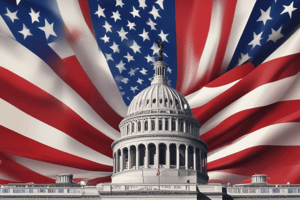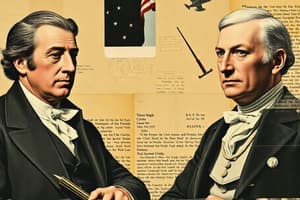Podcast
Questions and Answers
What was a major reason for the ineffectiveness of the Articles of Confederation?
What was a major reason for the ineffectiveness of the Articles of Confederation?
- Inability to collect taxes (correct)
- Failure to address foreign relations
- Lack of a standing army
- Inability to draft a constitution
Who were the Federalists, and what did they advocate for?
Who were the Federalists, and what did they advocate for?
- Stricter local governance and state rights
- A strong federal government capable of tax collection (correct)
- Establishment of a monarchy
- Immediate independence from Britain
Which event highlighted the need for a stronger government in the U.S. after the war?
Which event highlighted the need for a stronger government in the U.S. after the war?
- The Constitutional Convention
- The Boston Tea Party
- Shays' Rebellion (correct)
- The signing of the Treaty of Paris
What were the views of Anti-Federalists regarding a strong central government?
What were the views of Anti-Federalists regarding a strong central government?
What significant impact did Shays' Rebellion have on political leaders?
What significant impact did Shays' Rebellion have on political leaders?
What was Daniel Shays' goal during the uprising in Massachusetts?
What was Daniel Shays' goal during the uprising in Massachusetts?
In Abigail Adams' view, how did she perceive the participants of Shays' Rebellion?
In Abigail Adams' view, how did she perceive the participants of Shays' Rebellion?
What did George Washington imply about human nature when forming the confederation?
What did George Washington imply about human nature when forming the confederation?
What was one significant weakness of the Articles of Confederation?
What was one significant weakness of the Articles of Confederation?
What event was prompted by the perceived weaknesses of the Articles of Confederation in 1786?
What event was prompted by the perceived weaknesses of the Articles of Confederation in 1786?
Which plan proposed a two-house Congress based on proportional representation?
Which plan proposed a two-house Congress based on proportional representation?
What solution did the delegates ultimately agree upon regarding representation in Congress?
What solution did the delegates ultimately agree upon regarding representation in Congress?
What was the purpose of the Electoral College as introduced by Madison?
What was the purpose of the Electoral College as introduced by Madison?
What was a key concern regarding the election of a single chief executive?
What was a key concern regarding the election of a single chief executive?
Which compromise was reached regarding the issue of slavery in the Constitution?
Which compromise was reached regarding the issue of slavery in the Constitution?
How many states needed to ratify the Constitution for it to become law?
How many states needed to ratify the Constitution for it to become law?
Which document did Madison, Jay, and Hamilton write to support the ratification of the Constitution?
Which document did Madison, Jay, and Hamilton write to support the ratification of the Constitution?
What did the delegates ultimately fear concerning the electorate during the debates?
What did the delegates ultimately fear concerning the electorate during the debates?
What role did Washington play during the Constitutional Convention?
What role did Washington play during the Constitutional Convention?
Which of the following was NOT one of the founding fathers present at the Constitutional Convention?
Which of the following was NOT one of the founding fathers present at the Constitutional Convention?
Why did smaller states reject the Virginia Plan initially?
Why did smaller states reject the Virginia Plan initially?
What was the significance of the Bill of Rights in the ratification of the Constitution?
What was the significance of the Bill of Rights in the ratification of the Constitution?
Flashcards
Weaknesses of the Articles of Confederation
Weaknesses of the Articles of Confederation
The Articles of Confederation was the first government of the United States, but lacked the power to tax or regulate trade, leading to economic instability and conflicts like Shays' Rebellion.
Shays' Rebellion
Shays' Rebellion
A rebellion led by Daniel Shays, a former Continental Army captain, during which farmers in Western Massachusetts protested against high taxes and foreclosures. This rebellion demonstrated the weaknesses of the Articles of Confederation and the need for a stronger national government.
Federalists
Federalists
Supporters of a stronger central government, who argued for a new Constitution to address the weaknesses of the Articles of Confederation.
Anti-Federalists
Anti-Federalists
Signup and view all the flashcards
The Federalist Papers
The Federalist Papers
Signup and view all the flashcards
Alexander Hamilton
Alexander Hamilton
Signup and view all the flashcards
Thomas Jefferson
Thomas Jefferson
Signup and view all the flashcards
George Washington and the Articles of Confederation
George Washington and the Articles of Confederation
Signup and view all the flashcards
Articles of Confederation
Articles of Confederation
Signup and view all the flashcards
Annapolis Convention
Annapolis Convention
Signup and view all the flashcards
Constitutional Convention
Constitutional Convention
Signup and view all the flashcards
Separation of Powers
Separation of Powers
Signup and view all the flashcards
Great Compromise
Great Compromise
Signup and view all the flashcards
Electoral College
Electoral College
Signup and view all the flashcards
Federalist Papers
Federalist Papers
Signup and view all the flashcards
Ratification
Ratification
Signup and view all the flashcards
Judicial Review
Judicial Review
Signup and view all the flashcards
3/5 Compromise
3/5 Compromise
Signup and view all the flashcards
Amendment Process
Amendment Process
Signup and view all the flashcards
Bill of Rights
Bill of Rights
Signup and view all the flashcards
Constitution
Constitution
Signup and view all the flashcards
Study Notes
The State of the Nation at War's End (1783-1788)
- The Articles of Confederation were ineffective due to the inability to collect taxes, govern properly, and address issues quickly.
- The first US political party, the Federalists (Liberals), emerged, advocating for a strong federal government able to tax. Key figures were Alexander Hamilton, John Adams, John Jay, and James Madison.
- Anti-Federalists (Conservatives) opposed a strong central government; key figures included Thomas Jefferson, Patrick Henry, and James Monroe.
- Economic problems first hit Massachusetts, leading to tax rebellions by farmers in western Massachusetts (Shays' Rebellion). Farmers were unable to pay taxes due to low crop yields and foreclosures on their farms.
- Led by Daniel Shays, 1,500 armed farmers attacked courthouses with the intent to march to Boston.
- The rebellion was put down, but it highlighted the need for a stronger national government to address such insurrections.
- Rumors and panic spread about the rebellion among the elite, exaggerating its scope and influence.
- Supporters of a strong national government advocated for a revision of the Articles.
- Abigail Adams, a wealthy Eastern Massachusettes elite, viewed Shays' rebels as ignorant and lawless, a detrimental element to the struggle for stability. Thomas Jefferson countered this sentiment by comparing the need for revolution with the necessity to nurture liberty and democratic principles.
Creating a Government: Writing the U.S. Constitution
-
The Articles of Confederation failed because each state functioned essentially as an independent nation. There was no national mechanism to tax or enforce laws creating a lack of unity amongst states.
-
In 1786, five states sent delegates to the Annapolis Convention to discuss weaknesses in the Articles. Hamilton urged Congress to convene in 1787 to address the government's shortcomings.
-
The Constitutional Convention was held in Philadelphia in 1787 to revise, but ultimately rewrite the Articles of Confederation.
-
Fifty-five delegates from twelve states attended the convention. Rhode Island did not attend. Delegates were young, college-educated, representing various professions (farmers, merchants, lawyers and bankers).
-
Key figures like Washington, Madison, and Franklin, attended, but some key figures like Patrick Henry and Thomas Jefferson were absent.
-
Madison proposed the Virginia Plan, proposing a bicameral Congress based on proportional representation tied to population per state, empowering Congress to collect taxes, regulate commerce,and veto state laws.
-
The Virginia Plan focused on creating a strong national executive and federal courts.
-
Smaller states opposed the Virginia Plan because it gave disproportionate power to larger states; the New Jersey plan was introduced which advocated for equal state representation in a unicameral Congress in contrast.
-
The Great Compromise resolved the standoff. Representation in the House of Representatives would be based on population. The Senate would provide equal representation for each state with two senators.
-
The delegates agreed that a single executive would be needed but were unsure of the selection process.
-
The Electoral College emerged as a compromise selection method for the president, allowing each state a certain number of Electoral Votes based on their representation in Congress (senators + representatives).
-
The delegates debated presidential power and ultimately granted the president limited powers to sign laws into effect, veto power, commander-in-chief powers, and the power to appoint officials and judges.
-
The Supreme Court was established with power to declare laws unconstitutional. Fear of tyranny of the majority motivated the delegates.
-
The issue of slavery was highly controversial. The North advocated for its abolition; the South relied on it economically. The result was the 3/5th Compromise (slaves counted as 3/5 of a person) and agreement that Congress could prohibit the importation of slaves in 1808. Runaway slaves were to be returned to their owners from states they had fled.
-
The Constitution was sent to the states for ratification. Nine states needed to approve it. Federalist Papers were written to advocate for the Constitution.
-
Key figures like Madison, Jay, and Hamilton were authors of Federalist Papers.
-
Virginia and New York ultimately approved the Constitution, but only after debates among Federalists and Anti-Federalists. The Anti-Federalist concern lead to a call for a Bill of Rights.
-
The Constitution was enacted and became the law of the land on September 17, 1789.
Studying That Suits You
Use AI to generate personalized quizzes and flashcards to suit your learning preferences.





